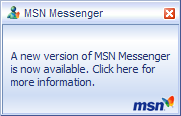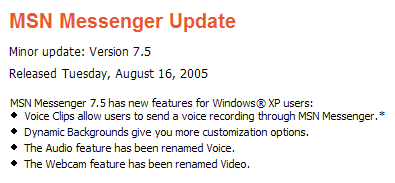Oh app, for crying out loud, go update yourself
When I start my PC these days, I see six or seven different applications in the Windows system tray screaming for attention. “An update is available! Update me!” “No—Update ME!” they cry. Great. Another click, another progress bar, another completely minor upgrade accomplished. One wonders: is there a meaningful role for the user in this process at all?
When it comes to updates, companies making client software have an enormous disadvantage versus web-based competitors. Deploying new server bits is a problem of considerable complexity in its own right, but at least the web software company gets to decide when to deploy and who conducts the upgrade. The user has no choice whether to use the updated site or not. In my own experience, most site updates seem to go rather well (your mileage may vary), so it’s not something I even pay attention to.
The client software manufacturer, meanwhile, has the challenging task of deploying bits to a quantity of machines orders of magnitude greater in size. The target machines could be running in any number of configurations the manufacturer isn’t even aware of, much less have in their test matrix. The update process is under the supervision of a user who generally has no idea what to do if something goes wrong.
Nevertheless, the mere existence of the constantly upgrading web-based competitor puts considerable pressure on the client software manufacturer to make the update process as transparent as possible. To be sure, client software updates are much less of a pain than they used to be. DLL hell is, by and large, no longer a nightmare plaguing every single update. Persistent broadband connections make checking for updates easy, and downloading new bits quick. In the vast majority of cases, the user needs to supply no additional data, the updates fall under EULAs the user has already agreed to, and the software already knows where it should be installed.
So why make the user agree to the update at all? Why not just do the update for them—at least in the cases where the user doesn’t have to do anything else?
Users at the extreme end of the techno-savvy spectrum may demand the ability to control when updates happen. Let’s stipulate that they should have the right to do so. I expect that most users, however, don’t care to exercise this right. I think the average person would only ask the following of any client software manufacturer regarding updates:
Rule 1: Don’t screw up my PC. This includes things like surreptitiously switching my home page, spamming my desktop, etc.
Rule 2: Don’t try to upgrade your product when I’m in the middle of using it. In general, don’t distract me from what I’m doing right now. To be honest, you’re really not that important to me.
Rule 3: Don’t reboot my PC. That’s rude. Whatever Adobe Acrobat Reader is doing that requires a reboot isn’t worth it to me.
I think that’s about it. Is the typical client software upgrade user experience these days actually supporting these goals?
Following a reboot on my main home PC, MSN Messenger (now called Windows Live Messenger) is the application most likely to be yelling for attention. Its upgrade experience is at the, er, “good” end of the user experience continuum for these sorts of things.

This little window that pops up is called a “toast” by the MSN design team because it pops up like a piece of toast. This particular piece of toast is lying. Clicking it brings up a dialog that does not, in fact, offer any more information.

Instead, the toast has actually tricked the user into starting the upgrade process. (For the record, this particular upgrade to MSN Messenger Version 7.5 will require a reboot.) The user can try to leave, but only by being forced to agree to be bothered again later. The user can click yet another button to see a web page that (finally) tells them why they should care about this upgrade:

It’s interesting to wonder which of the features listed above was the one that required a reboot.
In any event, the list of new features is beside the point. The placement of this information—three clicks away from the user—makes this fact obvious. The user has no choice in this process. It really doesn’t matter whether they like the new features or not. The manufacturer has updated the software, and will at some point stop supporting the old software. The user is going to have to upgrade at some point, or run the risk of being shut out when they really do need the service.
Why can’t the manufacturer simply arrange to have the client software automatically upgrade itself at some convenient time?
First, there’s the matter of preference—the user might not actually prefer the new software to the old software. This is entirely likely, but allowing them to keep running the old version seems like an incredibly inefficient solution to the problem. This creates tribes of users running old versions, complicating maintenance and improvement of both the client and server software. The enormous resources thus wasted could be put to better use finding out why people hate the new software and addressing the core design issues. This is what good web sites do. Or, if the differences are irreconcilable, the manufacturer can resort to leaving in program options that preserve aspects of the old user experience. In any event, making upgrades optional simply delays the inevitable disappointment of a forced upgrade when the manufacturer eventually can no longer support the old version.
Second, there’s the matter of bad upgrades. Sometimes this is because the manufacturer wrote buggy code. Postponing the upgrade isn’t going to fix this problem—the user is going to play upgrade roulette at some point. As noted earlier, the hapless user’s hardware and software stack may operate in a configuration outside of the manufacturer’s testing matrix. If this really is a critical reason to leave upgrades under a user’s control, then the existing user experiences fall far short of actually supporting this goal.
The problem is that no upgrade experience I’ve seen actually helps the user conduct a realistic evaluation of whether they can expect the upgrade to go smoothly in their configuration. As seen above, upgrade announcements for most applications are entirely rosy lists of new features, with no indication of what might go wrong. The little pop-up toast affords no links to resources such as upgrade FAQs, knowledge base articles, or most importantly, current user discussions of issues related to the upgrade. Users who care about upgrades currently must find this information on their own.
Given that the mainstream user can’t invest that kind of time, the only user experience that makes sense for them is automatically upgrading them at a convenient time (e.g., the machine is idle and it’s the middle of the night). If the program is in use, the program should at least download the bits, install as much as it can, and be prepared to cut over to the new version when the user next restarts the application. (Mozilla Firefox does this, although with too many dialogs for my taste.)
To support those users who want to carefully manage the upgrade process, the manufacturer can offer an option for manual upgrades. This option should—quietly—notify users when an upgrade is available. Since the mainstream user can’t be bothered to understand that option, the option should default to automatic upgrades. This scheme is, in fact, the route that Microsoft has finally taken with Microsoft Windows upgrades. Their user experience certainly isn’t ideal, and yet on balance Automatic Updates probably saves far more grief than it inflicts. Given the challenge of the client software upgrade problem, that’s about as good as anyone can expect.